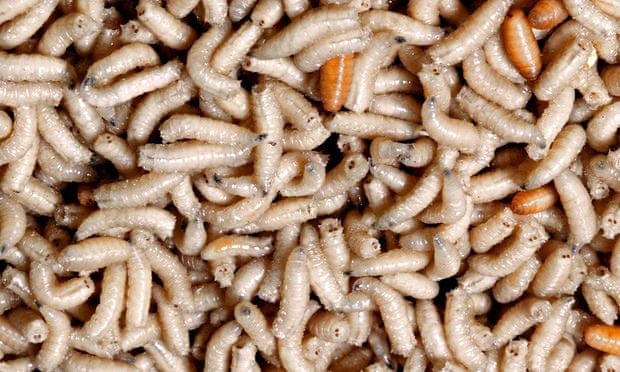
Insects could feed the animals of tomorrow’s meat
industry
Is a
sustainable food industry a hamburger made from a pig reared on insect feed?
Convoluted legislation and possible health risks pose a challenge
AgriProtein will rear enough flies (about 8.5bn) to
produce seven tonnes of their maggot-based feed, MagMeal, every day.
Photograph: ACE STOCK LIMITED / Alamy/Alamy
It works like this. AgriProtein collects
abattoir waste and processes it into a feed for fly larvae. Cages are used to
attract the flies to breed, and once their eggs have hatched, the larvae are
dried and compressed into flakes or powder. The resulting mix is delivered to
animal feed mills.
While a number of startups are trying to
excite our taste buds by presenting insects in the form of cookies and
tortilla chips, others such as AgriProtein are exploring how the
nutrients in meat industry waste – blood, brains, guts – and manure can be
recycled to produce insect feed for animals that are currently fed on the likes
of fishmeal and soybean meal.
Jason Drew, co-founder of the South African
startup which he set up with his brother David in 2010, says: “A third of all
the fish we take out of our seas is ground up into fishmeal. The catches are
unsustainable and the falling supply and increasing demand are leading to
prices hitting new highs.”
AgriProtein raised $11m in funding this year. The money has
helped Drew and his team to raise production to a level not seen before. Their
first large-scale factory, which will start operating in 2015, will rear enough
flies (about 8.5bn) to produce seven tonnes of their maggot-based feed, MagMeal, every day.
“We’ll produce 24 tonnes of larvae a day,”
adds Drew. “That’s 24 tonnes of fish we don’t need to take from the sea, and
less waste to landfill.”
Video showing how MagMeal takes the pressure off the
oceans by reducing the need for fishmeal
The United Nations Food and Agriculture
Organisation released a report (pdf)last year promoting the
introduction of insects into both our diets and animal feed. It estimates that
a burgeoning population will mean demand for meat and cereal will have
increased sharply by 2050, affecting the supply and prices of animal feed. Teun
Veldkamp, a senior researcher at Wageningen University’s Centre for Animal Nutrition,
says that “other protein sources for livestock and aquaculture are urgently
needed” and that insects are ideal because they can be “sustainably reared” on
vegetable and domestic waste as well as byproducts from slaughterhouses.
Advertisement
Some scientists believe that the answer to
providing more protein could be artificial meat and products made from grounded
insects, but startups recognise that for consumers, the thought of directly
eating insects is often hard to stomach. A hamburger that comes from a pig
reared on insect feed might be more palatable than a burger bun made from
cricket flour.
AgriProtein’s maggot feed has been approved in
South Africa for fish and chickens, but insects are subjected to varying
convoluted regulatory processes in different countries. In the EU for instance,
insects are treated like livestock once they have been dried and converted into
a flake or powder form – the legislation was introduced in 2001 following
an outbreak of mad cow disease. It means that processed animal proteins are
banned from the feed of animals reared for human consumption. There is also a
law against farmed animals being raised on waste such as manure.
Some experts, such as the team behind
PROteINSECT, an EU-funded project investigating how flies can contribute to
meeting future demands for protein, believe that more data and information (pdf) needs to be
made available. There is a worry that insects used in animal feed could carry
certain bacteria, and it’s unknown how much of a health risk this could pose to
humans.
Despite concerns, Kees Aarts, co-founder of
the Dutch startup Protix
Biosystems, believes that sceptical members of the public shouldn’t
think that businesses like his are merely rushing to join the insect-eating
movement.
“Rushing things sounds like carelessness. It
implies insects couldn’t provide high-quality nutrients,” says Aarts. “They
can, and more importantly they can be produced with the highest safety and
quality standards.”
Protix Biosystems set up the IPIFF
(International Producers of Insects for
Feed and Food) with other insect producers to help provide legislators with
information on safety and quality. Its products are ready and awaiting approval
to be made commercially available outside of the pet food market.
Aarts suggests that the legislation to allow
insects in pig and poultry feed will change sooner rather than later – it was
revised to allow use in aquaculture feed last year – and that it would be
absurd if it didn’t. “As a feed ingredient it’s common sense … nature’s
principles apply,” he says. After all, chickens tend to roam around and dig in
the dirt for their fair share of bugs to gobble. Startups like his and Drew’s
want to provide pigs and poultry with certified insects, and at the same time,
move back closer to nature by creating a circular food chain.
No comments:
Post a Comment